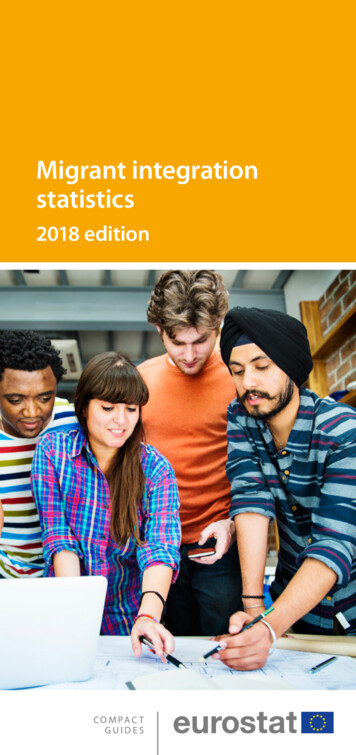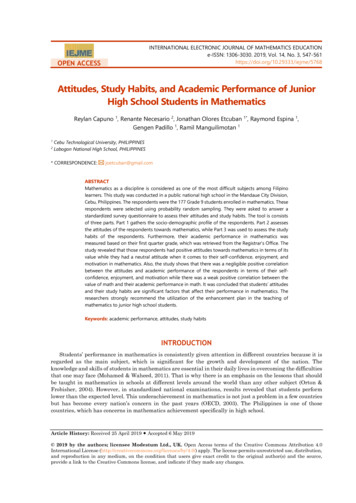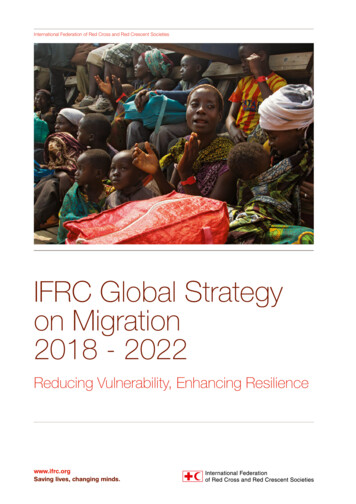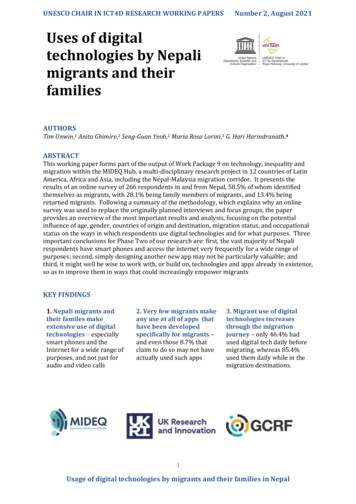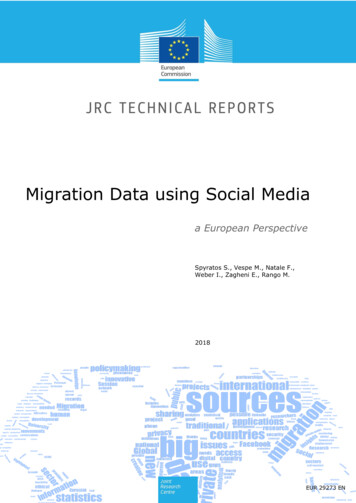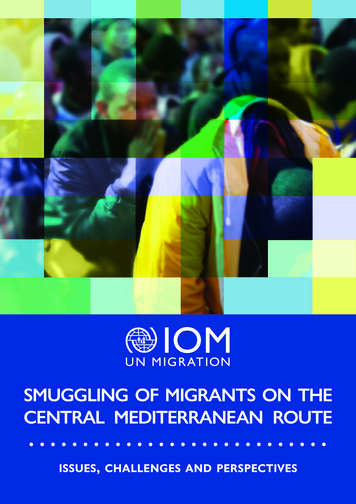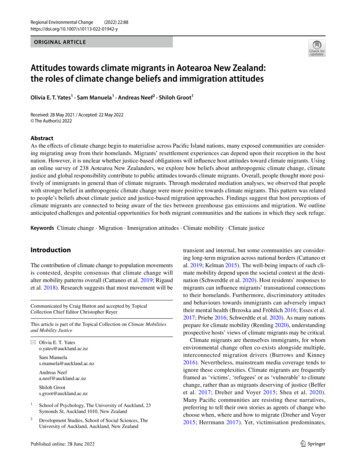
Transcription
Regional Environmental Change(2022) GINAL ARTICLEAttitudes towards climate migrants in Aotearoa New Zealand:the roles of climate change beliefs and immigration attitudesOlivia E. T. Yates1 · Sam Manuela1 · Andreas Neef2 · Shiloh Groot1Received: 28 May 2021 / Accepted: 22 May 2022 The Author(s) 2022AbstractAs the effects of climate change begin to materialise across Pacific Island nations, many exposed communities are considering migrating away from their homelands. Migrants’ resettlement experiences can depend upon their reception in the hostnation. However, it is unclear whether justice-based obligations will influence host attitudes toward climate migrants. Usingan online survey of 238 Aotearoa New Zealanders, we explore how beliefs about anthropogenic climate change, climatejustice and global responsibility contribute to public attitudes towards climate migrants. Overall, people thought more positively of immigrants in general than of climate migrants. Through moderated mediation analyses, we observed that peoplewith stronger belief in anthropogenic climate change were more positive towards climate migrants. This pattern was relatedto people’s beliefs about climate justice and justice-based migration approaches. Findings suggest that host perceptions ofclimate migrants are connected to being aware of the ties between greenhouse gas emissions and migration. We outlineanticipated challenges and potential opportunities for both migrant communities and the nations in which they seek refuge.Keywords Climate change · Migration · Immigration attitudes · Climate mobility · Climate justiceIntroductionThe contribution of climate change to population movementsis contested, despite consensus that climate change willalter mobility patterns overall (Cattaneo et al. 2019; Rigaudet al. 2018). Research suggests that most movement will beCommunicated by Craig Hutton and accepted by TopicalCollection Chief Editor Christopher ReyerThis article is part of the Topical Collection on Climate Mobilitiesand Mobility Justice* Olivia E. T. Yateso.yates@auckland.ac.nzSam Manuelas.manuela@auckland.ac.nzAndreas Neefa.neef@auckland.ac.nzShiloh Groots.groot@auckland.ac.nz1School of Psychology, The University of Auckland, 23Symonds St, Auckland 1010, New Zealand2Development Studies, School of Social Sciences, TheUniversity of Auckland, Auckland, New Zealandtransient and internal, but some communities are considering long-term migration across national borders (Cattaneo etal. 2019; Kelman 2015). The well-being impacts of such climate mobility depend upon the societal context at the destination (Schwerdtle et al. 2020). Host residents’ responses tomigrants can influence migrants’ transnational connectionsto their homelands. Furthermore, discriminatory attitudesand behaviours towards immigrants can adversely impacttheir mental health (Brzoska and Fröhlich 2016; Esses et al.2017; Priebe 2016; Schwerdtle et al. 2020). As many nationsprepare for climate mobility (Remling 2020), understandingprospective hosts’ views of climate migrants may be critical.Climate migrants are themselves immigrants, for whomenvironmental change often co-exists alongside multiple,interconnected migration drivers (Burrows and Kinney2016). Nevertheless, mainstream media coverage tends toignore these complexities. Climate migrants are frequentlyframed as ‘victims’, ‘refugees’ or as ‘vulnerable’ to climatechange, rather than as migrants deserving of justice (Belferet al. 2017; Dreher and Voyer 2015; Shea et al. 2020).Many Pacific communities are resisting these narratives,preferring to tell their own stories as agents of change whochoose when, where and how to migrate (Dreher and Voyer2015; Herrmann 2017). Yet, victimisation predominates,13Vol.:(0123456789)
88Page 2 of 12Fig. 1 Conceptual model of the direct (Path C) and indirect (PathsA-B) relationships between climate change beliefs and attitudestowards climate migrants. ACC anthropogenic climate change. Distributive justice support for distributive-justice based initiatives toaccommodate climate migrantsultimately dehumanising, disempowering and ‘othering’Pacific communities in the reader’s mind (Herrmann 2017).Using an online survey in Aotearoa1 New Zealand(Aotearoa NZ), we first investigate how attitudes towardsclimate migrants compare to those towards immigrantsin general (hereafter: just ‘immigrants’). We ask whetherthere are differences between host perceptions of climatemigrants compared to immigrants (Hypothesis 1 (H1)). Wethen explore patterns that may underlie potential differences,asking if attitudes towards climate migrants are mediated byclimate change beliefs and perspectives on climate change(H2–5).Figure 1 conceptualises our hypotheses. As per path C,people’s belief in climate change may be related to their attitudes towards climate migrants. However, this relationshipmight be explained by their support for distributive justice,the belief that wealthy states should support others moreaffected by climate change (Pottier et al. 2017) (paths A–B).Yet, to endorse distributive justice, one must first understandboth anthropogenic climate change (ACC) and its unevendistribution (climate justice awareness). Hence, people’sbelief in ACC may combine with their climate justice awareness to predict their stance on distributive justice (path A),and in turn, their attitudes towards climate migrants (pathB). The following sections explain these concepts further.Attitudes towards climate migrantsAttitudes towards migrants often reflect perceptions of thecause of migration. In the case of climate mobility, thecauses are multifaceted and complex. In addition, climatemobility is rarely purely voluntary, being enmeshed indestabilised economic and political systems (Kelman 2015).Public understanding of these interconnections can derivefrom their relationships with immigrants, histories of environmental change and the dominant climate change narratives (Echterhoff et al. 2020; Lujala et al. 2020). In Germany1Māori name for New Zealand.13Regional Environmental Change(2022) 22:88(Arias and Blair 2022; Helbling 2020) and the USA (Ariasand Blair 2022), residents regarded cross-border climatemigrants as being forced to migrate, similar to politicalmigrants or refugees, and more deserving of asylum thaneconomic migrants, those who seek a better quality of life.Yet, in Kenya and Vietnam, internal climate migrants andeconomic migrants are seen to have equally valid reasons tomigrate (Spilker et al. 2020). The authors suggest that residents in lower-income countries may see economic migration as a consequence of untenable living conditions created by climatic instabilities. Given that perceptions of causecan influence perceptions of climate migrants, we anticipatethat Aotearoa New Zealanders’ (Aotearoa NZers) attitudestowards climate migrants will differ from their attitudestowards immigrants in general.H1: There are differences in attitudes towards climatemigrants compared to immigrants in general.Such differences may also relate to whether peoplebelieve that climate change is a valid reason to migrate.Psychological research consistently relates beliefs aboutclimate change to greater pro-environmental intentions,behaviours and climate policy support (e.g. Hornsey et al.2016; Milfont et al. 2017). Knowledge of climate change canalso inform peoples’ perceptions of threat (Van der Linden2015). Similarly, understandings of migration drivers andconsequences can influence host resident attitudes. People tend to be more positive towards involuntary migrantsthan voluntary migrants (Verkuyten et al. 2018), especiallythose migrating due to persecution, war or after experiencingextreme suffering (Bansak et al. 2016; Echterhoff et al. 2020;Kotzur et al. 2019). Hence, hosts who believe in ACC maysee climate change as a more serious risk to people’s livelihoods, and therefore they could hold more positive attitudestowards climate migrants (Fig. 1, path C).H2: Belief in ACC is related to more positive attitudestowards climate migrants.Climate justiceAttempts to understand attitudes towards climate migrantsare complexified when considering responsibility for climatemobility. Whereas political and economic migrants oftenmove to regions that are disconnected from the cause oftheir misfortune (e.g. persecution or economic instability,Burrows and Kinney 2016; Koubi 2019), climate migrantstend to move towards the perpetrator—although host communities may not see themselves as such. Adopting a climatejustice lens can highlight the links between displacementand host greenhouse gas emissions. Climate justice recognises that climate change impacts differ across locations and
Regional Environmental ChangePage 3 of 12(2022) 22:88generations, and that they are more acute for groups experiencing other historically or socially constructed vulnerabilities. These impacts are often disproportionate to nationalgreenhouse gas emissions, with many low-emitting nationsbearing the burden of climate impacts (Gach 2019; Kanbur2018).Proponents of climate justice generally call for the fairdistribution of climate burdens and benefits. They emphasise distributive justice, the allocation of material and socialresources to those with less income and political influence(Kanbur 2018; Schlosberg and Collins 2014). Many climatejustice advocates call for the insertion of distributive justice into migration governance. They argue that migrationpolicies must reflect the association between industrialisednations’ fossil fuel emissions and livelihood disruption inlow-polluting nations. Acknowledging their complicitycould then enhance their sense of responsibility to supportat-risk communities (Marshall 2016; Nawrotzki 2014). Governing bodies are encouraged to provide financial support,compensation for land loss, prioritise community-led solutions and ease immigration restrictions for the environmentally threatened (Skillington 2015).Taking together the importance of attribution (e.g. Esseset al. 2017) and distributive justice (Marshall 2016; Nawrotzki 2014), acknowledging responsibility for migrationmay inform people’s responses to climate migrants. Thatis, the more host residents believe that climate change hashuman origins (belief in ACC), the greater their sense ofresponsibility for supporting climate migrants (distributive justice), and the warmer their attitudes towards climatemigrants (Fig. 1, paths A and B). Hence, we hypothesisethat:H3: Greater belief in ACC is related to warmer attitudestowards climate migrants through greater support fordistributive justice.However, seeing oneself as complicit in migration maydepend upon understanding that climate impacts are unevenly distributed. We refer to this knowledge as ‘climate justice awareness’. According to Swim and Bloodhart (2018),knowledge of climate (in)justices may create a sense ofresponsibility for and a desire to minimise climate impacts.Indeed, Stanley and Williamson (2021) recently observedthat supporting equality was associated with willingness toaccept ‘climate refugees’. Therefore, the link between believing in ACC and endorsing distributive justice may rely uponpeople’s understandings of climate justice (Fig. 1, path A).H4: The relationships between belief in ACC and distributive justice depend upon awareness of climate justice.88Acculturation expectationsFinally, worries about socio-cultural shifts can also influence attitudes towards migrants. Concerns about the erosion of host identities, customs or institutions—often tosafeguard perceived social cohesion and societal privilege(Esses et al. 2017)—can engender hostility towards climatemigrants (Brzoska and Fröhlich 2016; Burrows and Kinney2016; Lujala et al. 2020). Host residents tend to prefer thatculturally similar migrants integrate (maintain both theirhome and host cultures) while culturally distinct migrantsare expected to assimilate (completely adopt the host cultureand values) (Berry 1997; Esses et al. 2017; Florack et al.2013). Support for integration or assimilation can relate toopenness to cultural diversity (Florack et al. 2013). Hence,acculturation expectations may also be related to attitudestowards climate migrants.H5: Assimilation and integration expectations are relatedto attitudes towards climate migrants.Migration to Aotearoa New ZealandAotearoa NZ is likely to host future climate migrants (Cass2018) and thus is the focus of this article. The nation’s publicand political discussion of climate mobility focuses almostexclusively on Pacific peoples (Cass 2018; Fuatai 2020; Ministry of Foreign Affairs and Trade [MFAT] 2018). AotearoaNZ is relationally and politically connected with the Pacificthrough its location, political priorities, shared colonial histories and ancestral connections between Pacific peoplesand Māori2 (MFAT 2018; Te Punga Somerville 2012). Distinct Pacific communities live in Aotearoa NZ, collectivelyconstituting 8.1% of the population (Statistics New Zealand2018a). However, Pacific peoples have been ‘othered’ by themedia, historically depicted as unmotivated and dependentupon Pākehā3 support (’Ofa Kolo 1990; Loto et al. 2006),and more recently, as dehumanised commodities during lowwage labour shortages (Enoka 2019).Pacific climate mobility sits within broader immigrationdiscourse. Aotearoa NZ is ethnically diverse, with 27.4%of the population being born overseas, many from the UK,China, India and Australia (Statistics New Zealand 2019a).Most Aotearoa NZers embrace this cultural diversity, endorsing a multicultural ideology, supporting integration andappreciating immigrants’ contribution to society (Spoonley2015; Ward and Masgoret 2008). Yet, multicultural ideals2Māori refers to the Indigenous people of Aotearoa NZ.Pākehā refers to the majority group with European descent whosevalues and customs reflect their New Zealand location (see Spoonleyand Butcher 2009).313
88Page 4 of 12tend to gloss over engrained racism, persistent inequalitiesbetween ethnic groups and resistance to shifts in the ‘preexisting’ neoliberal and capitalist values of the Pākehā settler majority (Harris et al. 2018; Lyons et al. 2011).Aotearoa NZers’ attitudes to climate migrants emergefrom this context. Nearly a decade ago, Allwood (2013)reported that some Aotearoa NZers support climate mobility because of Aotearoa NZ’s Pacific connections, despiteconcerns that Pacific climate migrants would be a ‘welfareburden’ (p. 61) or ‘change the New Zealand [sic] socialstructure’ (p. 79). Since then, climate justice has beenincreasingly centred in climate policy (Gach 2019), Pacificpeoples’ calls for climate justice have become more vociferous (Tahana 2019) and many Aotearoa NZers have reportedsupporting ‘climate refugee’ policy (Stanley and Williamson 2021). It is uncertain whether these trends translate intogreater climate justice awareness, responsibility to acceptclimate migrants, and positive attitudes towards climatemigrants overall. Moreover, it is uncertain how these factorsintersect with existing perspectives on immigration.Therefore, we seek to understand whether AotearoaNZers’ complicity in climate mobility contributes to theirattitudes towards climate migrants. Through a cross-sectional survey using an online convenience sample, we firsttest whether there are underlying differences in attitudestowards climate migrants, compared to other immigrants(H1). Then, summarising our hypotheses through the conceptual model (Fig. 1), we assess whether perceptions ofclimate migrants are mediated by climate change beliefs.In Fig. 1, path C tests the direct effect: that belief in ACCis related to attitudes towards climate migrants (H2). PathsA and B test the indirect effect: that support for distributivejustice mediates the association between belief in ACC andattitudes towards climate migrants (H3). Finally, path A teststhe conditional indirect effect: that awareness of climate justice moderates the relationship between belief in ACC anddistributive justice (H4).MethodDataData were generated through a cross-sectional online questionnaire on Aotearoa NZers’ attitudes towards climatechange and migration, administered from December 2019to March 2020. People self-selected through volunteer andsnowball sampling in response to a Facebook advertisement.The advertisement was ‘seeking participants for a surveyon migration and climate change’ and was incentivised bya prize draw to win one of four vouchers. The present analyses employ a subset of questions within a larger batteryof measures on climate change and migration. A total of13Regional Environmental Change(2022) 22:88238 people aged 18–86 years completed the questionnaire.This is considered a medium-sized sample in psychologicalresearch (Feng et al. 2020). More women (55.6%), Pākehā(87.0%) and tertiary-educated people (58.5%) were represented in this convenience sample than in the Aotearoa NZpopulation (see Table 1 for population-wide comparisons).Although not completely representative, a range of differentparticipants completed the survey.Climate change measuresThe questionnaire included four climate change measures,assessed on a Likert scale ranging from 1 to 7 (1: stronglydisagree; 7: strongly agree). Questions on climate changereality and belief in anthropogenic climate change, previously demonstrated to predict environmental behaviours(e.g. Hornsey et al. 2016; Milfont et al. 2017; Van der Linden et al. 2019), were derived from the New Zealand Attitudes and Values Study (NZAVS, Sibley 2018). To gaugeclimate justice awareness, participants responded to threequestions (Cronbach’s alpha, α 0.86) about the unequaldistribution of climate impacts across generations, locationsand household income, e.g. ‘My or my friends’ children willexperience more extreme weather events in their lifetimesthan I will’. Distributive justice, i.e. the belief that countriesshould support others more affected by climate change (Pottier et al. 2017), was measured from the average of threeitems (α 0.74) adapted from Allwood (2013). See OnlineResource I for details.Immigration measuresWe adapted perspectives on immigration from Ward andMasgoret (2008). Before answering, respondents were provided with a definition for ‘climate migrants’ but not for‘immigrants’, as climate migrants do not frequently featurein mainstream discourse in Aotearoa NZ, unlike immigrants(Spoonley and Butcher 2009; Zaman and Das 2020). Theterm ‘climate migrants’ was chosen to reflect current policydiscussion and avoid the more divisive term ‘climate refugees’ (Kelly 2020; Zaman and Das 2020).We first asked all respondents about their attitudestowards immigrants (α 0.83) then climate migrants(α 0.92) for a within-person comparison of attitudestowards (im)migrants. The variables were assessed fromthree items measured on a Likert scale from 1 to 7 (1:strongly disagree; 7: strongly agree), e.g. ‘The unity of NewZealand is enhanced by immigrants’/ ‘The unity of New Zealand will be enhanced if we accommodate climate migrants’.We employed tense differences to match the framing of climate mobility in public discourse as a distant phenomenonrather than a present reality (Zaman and Das 2020).
Regional Environmental ChangePage 5 of ) 22:88Table 1 Descriptive statistics for the sample and the Aotearoa NZ population across survey variablesVariablen ( 236)Attitudes towards migrants (1 more negative, 7 more positive)Attitudes towards immigrantsAttitudes towards climate migrantsAssimilation expectations (1 low, 7 high)For immigrantsFor climate migrantsIntegration expectations (1 low, 7 high)For immigrantsFor climate migrantsClimate change beliefs (1 strong disbelief, 7 strong belief)RealityAnthropogenic climate change (ACC)Climate justice awarenessDistributive justiceDemographic characteristicsAge (median)Household income ( NZ)Political orientation (1 liberal, 7 conservative)Ethnicity1 (yes 1; no n23Not elsewhere classified3Gender4,5 (yes 1; no male)Male102Female131Non-binary or gender diverse3Education6High school46Associate/technical degree/diploma51Bachelor’s degree83Postgraduate qualification9Master’s degree40Doctor’s A𝜇37210570030.860.741.85Note. Immigration and climate change measures recorded on a Likert scale from 1 to 71Defined as per Statistics New Zealand (2018a, 2019a). Frequencies do not sum to 100% as respondents could identify with more than one ethnic group23456Statistics New Zealand (2019b)Ministry of Business, Innovation and Employment (n.d.)Statistics New Zealand (n.d.)Statistics New Zealand (2021)Statistics New Zealand (2018b)Acculturation expectations, including for assimilationand integration, were measured from single items adaptedfrom Allwood (2013). Both expectations were separatelymeasured for climate migrants and immigrants, e.g.‘Immigrants should fully adopt New Zealand culture andvalues’, or ‘Climate migrants should maintain their cultures while also adopting New Zealand culture’.13
88Page 6 of 12Regional Environmental ChangeDemographic and political characteristics7Socio-political and demographic characteristics demonstrated elsewhere to be associated with climate change (e.g.McCright et al. 2014; Milfont et al. 2015) and migrationattitudes (e.g. Hainmueller and Hiscox 2007; O’Rourke andSinnott 2006) were controlled for in the analyses. Covariates included age, education, household income, gender,ethnicity and political orientation. Using these covariatesaccounted for the variation in our measures of interest thatwas solely related to the demographics of the self-selectedsample. To retain responses from underrepresented gender and ethnic groups, gender was assessed as male/othergenders (female, non-binary, transgender and intersex) andethnicity as Pākehā/non-Pākehā (Māori, Pacific, Asian,Middle Eastern, African and Latin American). Despiteoversimplifying experiences of structural inequality, thesevariables broadly reflect benefitting from the male or Pākehāhegemony compared to facing historical disadvantage (e.g.Spoonley 2015; Tan et al. 2019). Political orientation wasmeasured using one item, ‘Please rate how politically liberalversus conservative you see yourself as being’, measuredfrom 1 (liberal) to 7 (conservative) (Sibley 2018).6(2022) 22:88ImmigrantsClimate migrantsEmpirical methodsWithin-subjects MANCOVA was used to test for differences in attitudes towards (im)migrants and acculturationexpectations. The within-subjects MANCOVA assessed twodifferent measurements from the same participants, ratherthan the same measurement at separate time points. Withinparticipants designs are not without their pitfalls, notablycarry-over and researcher demand effects (Charness et al.2012). However, we selected this design because people’sattitudes towards immigrants are likely to inform ratherthan be independent of their perceptions of future climatemigrants.To test the conceptual model (Fig. 1), we employed moderated mediation analyses through Hayes (2013) PROCESSmacro for SPSS (model 7). Moderated mediation analysiscombines the effects of mediation and moderation to testthe conditional indirect effect. This tests whether the indirect effect—the effect of the predictor (belief in ACC) onthe outcome (attitudes towards climate migrants) throughthe mediator (distributive justice)—depends upon the levelof the moderator (climate justice awareness) (Hayes 2015;Preacher et al. 2007). Statistical significance of the overallmodel was assessed from the index of moderated mediation,which computes the relationship between the indirect effectand the moderator. This employed 95% bootstrap confidenceintervals of 5,000 bootstrap samples with homoscedasticityconsistent standard errors (Hayes 2013; 2015).13Attitudes54321Attitudes expectationsMeasureFig. 2 Attitudes towards migrants and acculturation expectations forimmigrants compared to climate migrants. Higher score indicatesmore positive attitudes or stronger expectations, adjusted for covariates. Covariates included age, education, income, political orientation, gender, ethnicity, and climate change reality. Error bars 95%confidence intervalsResultsTable 1 provides descriptive statistics of demographic,climate change and immigration variables used in theanalyses. First, a within-subjects MANCOVA wasperformed to test for baseline differences in migration attitudes, accounting only for climate change reality. These included significant differences in attitudestowards (im)migrants and acculturation expectations(Fwithin effects(2.20,511.42) 47.96, p 0.001, GreenhouseGeisser correction, see Online Resource II). To investigatethese differences further, we re-ran the analyses with allcovariates to control for demographic characteristics aswell as climate change reality. Most people agreed thatclimate migrants and immigrants in general made positive contributions to Aotearoa NZ, even when accounting for demographic differences (Fig. 2). However, attitudes towards migrants and acculturation expectationsdiffered, supporting H1, as shown from the MANCOVA(F within effects(2.55,512.09) 3.70, p 0.05, GreenhouseGeisser correction, see Online Resource II). People feltmore negatively towards climate migrants than they didtowards immigrants (Fig. 2, p 0.01). They expected bothmigrant groups to integrate more than assimilate into society (ps 0.01, post hoc tests with Bonferroni correction,Fig. 2 and Online Resource II). However, climate migrantswere expected to both assimilate and integrate less thanwere immigrants (ps 0.05). Migration attitudes also varied by climate change, gender and political orientation, asOnline Resource II details.
Regional Environmental ChangePage 7 of 12(2022) 22:8888Table 2 Coefficients for moderated mediation of attitudes to climate migrants on climate change beliefsPredictorBelief in ACC Climate justiceawarenessBelief inACC*Climate Justice AwarenessDistributive justiceIntegration expectationAssimilation expectationAgePākehācOther gendersdEducationIncomePolitical orientationeConstantR2F-statisticTest of unconditionalinteractionPaths A B: Indexof moderatedmediationPath C: Direct effect on attitudestowards climate migrantsPath A: Conditional indirect effect ondistributive justicePaths B and C’: Direct and indirecteffect on attitudes towards -0.13**95% CIb-----0.37*** 0.22***[0.03, 0.23][0.25, 0.49]-95% CIb0.23***0.33***[0.10, 0.37][0.18, 0.48]-0.06*[0.01, 0.10]-0.23***[ 0.32, 0.12] 0.08-[0.12, 0.34][ 0.18, 0.01]0.01[ 0.01, 0.02]0.01[0.00, 0.02]-0.30[ 0.672, 0.23]0.16[ 0.24, 0.55]0.53**[0.21, 0.86]0.43**[0.12, 0.74]0.12*[0.01, 0.23] 0.03[ 0.13, 0.07]0.00[0.00, 0.00]0.01[ 0.09, 0.07] 0.18**[ 0.30, 0.06] 0.14*[ 0.25, 0.24]2.67**[0.34, 3.46]3.54***[2.41, 4.67]0.630.69F(9, 211) 38.35***F(11,201) 41.50***R2 change 0.01F-statisticinteraction(1,201) 6.41*0.0695% CIb[ 0.04, 0.17]-0.21**0.32**[0.07, 0.03][0.20, 0.44] 0.19***[ 0.29, 0.10]0.004 0.280.45**0.12* 0.04 0.14*2.52***0.64F(10,202) 36.64***0.0118[ 0.01, 0.01][ 0.69, 0.13][0.12, 0.78][ 0.26, 0.02][ 0.12, 0.04][ 0.26, 0.02][1.24, 3.79][0.0002, 0.0267]Note. aUnstandardised coefficients. bCI—Confidence interval. c0—non-Pākehā, 1—Pākehā. d0—male, 1—female, non-binary or gender diverse.e1—very politically liberal, 7—very politically conservative. The following values were mean-centred: belief in ACC; climate justice awareness*p 0.05 (two-tailed test)**p 0.01 (two-tailed test)***p 0.001 (two-tailed test)Attitudes towards climate migrantsTo better understand people’s responses to climate migrants,we analysed the links between their climate change beliefsand their attitudes towards climate migrants. Using moderated mediation analyses (Hayes [2013] PROCESS model 7),we first tested the conceptual model (Fig. 1) without covariates, then later included covariates for the final analysis.Excluding covariates, each path of the model was significant(ps 0.001, Online Resource II) and the index of moderatedmediation was greater than zero (index 0.03 [0.01, 0.06]),suggesting that our overall model was significant.We then re-ran the model with covariates to account forsample bias, differences in demographic characteristics andacculturation expectations (Fig. 1; Table 2). For path C(Fig. 2), belief in ACC was related to attitudes towards climate migrants (p 0.01). On average, the more that peoplebelieved in ACC, the more positively they perceived climatemigrants, as per H2.Next, we tested the indirect effect (paths A–B). For pathA, belief in ACC and awareness of climate justice were positively related to support for distributive justice (p 0.001).Awareness of climate justice moderated the relationshipbetween belief in ACC and support for distributive justice,in line with H4 (interaction effect: ps 0.05, Table 2 andOnline Resource II). That is, the more that people believedthat climate change was human caused and were aware ofclimate justice, the more they believed that states had differentiated responsibilities towards climate migrants. However, these relationships depended upon people’s awarenessof the unequal spread of climate impacts. Specifically, aspeople’s belief in ACC increased, they were more likely tofeel responsible for supporting climate migrants, especiallyif they were also knowledgeable about climate justice.13
88Page 8 of 12For path B, being more supportive of distributive justice was significantly related to having more positive attitudes towards climate migrants (p 0.01, Table 2). Finally,we tested
pubi l iot ac / ns 7167- hwo - do- mhost - nt agr i xoi pr - semti i pehas - it t t a udes-woard-tinter nal-climate-miga rnts. Accessed 19 Sep 2020 Lyons AC, Madden H, Chamberlain K (2011) "It's not really us dis-criminating against immigrants, it's more telling people how to t in": constructing the nation in immigration talk in New .
